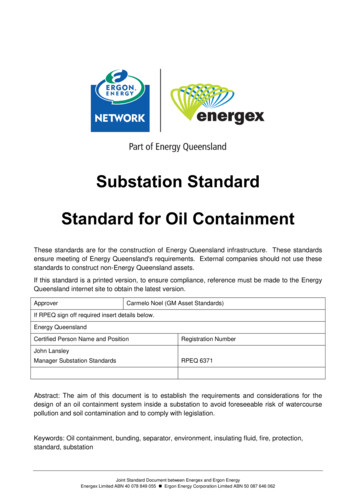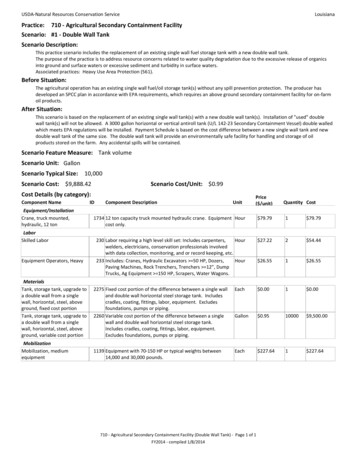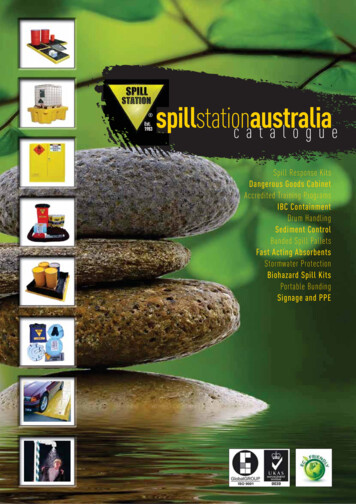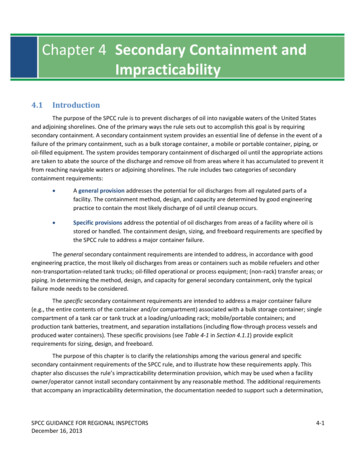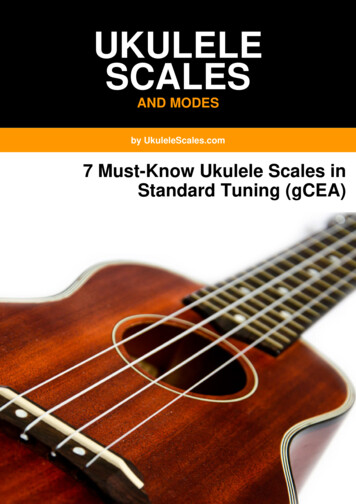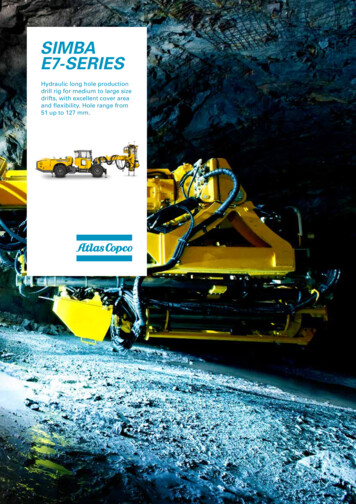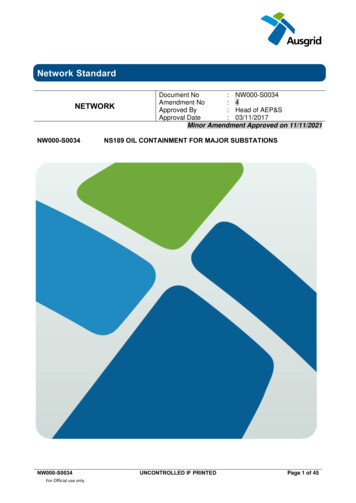
Transcription
Network StandardNETWORKNW000-S0034NW000-S0034For Official use onlyDocument No: NW000-S0034Amendment No: 4Approved By: Head of AEP&SApproval Date: 03/11/2017Minor Amendment Approved on 11/11/2021NS189 OIL CONTAINMENT FOR MAJOR SUBSTATIONSUNCONTROLLED IF PRINTEDPage 1 of 45
NS189 Oil Containment for Major SubstationsAmendment No 4ISSUEFor issue to all Ausgrid and Accredited Service Providers’ staff involved with the design of oil containment systems at majorsubstations, and is for reference by field, technical and engineering staff.Ausgrid maintains a copy of this and other Network Standards together with updates and amendments on www.ausgrid.com.au.Where this standard is issued as a controlled document replacing an earlier edition, remove and destroy the superseded documentDISCLAIMERAs Ausgrid’s standards are subject to ongoing review, the information contained in this document may be amended by Ausgrid at anytime. It is possible that conflict may exist between standard documents. In this event, the most recent standard shall prevail.This document has been developed using information available from field and other sources and is suitable for most situationsencountered in Ausgrid. Particular conditions, projects or localities may require special or different practices. It is the responsibility ofthe local manager, supervisor, assured quality contractor and the individuals involved to make sure that a safe system of work isemployed and that statutory requirements are met.Ausgrid disclaims any and all liability to any person or persons for any procedure, process or any other thing done or not done, as aresult of this Standard.All design work, and the associated supply of materials and equipment, must be undertaken in accordance with and consideration ofrelevant legislative and regulatory requirements, latest revision of Ausgrid’s Network Standards and specifications and AustralianStandards. Designs submitted shall be declared as fit for purpose. Where the designer wishes to include a variation to a networkstandard or an alternative material or equipment to that currently approved the designer must obtain authorisation from the NetworkStandard owner before incorporating a variation to a Network Standard in a design.External designers including those authorised as Accredited Service Providers will seek approval through the approved process asoutlined in NS181 Approval of Materials and Equipment and Network Standard Variations. Seeking approval will ensure NetworkStandards are appropriately updated and that a consistent interpretation of the legislative framework is employed.Notes: 1. Compliance with this Network Standard does not automatically satisfy the requirements of a Designer Safety Report. Thedesigner must comply with the provisions of the Workplace Health and Safety Regulation 2011 (NSW - Part 6.2 Duties of designer ofstructure and person who commissions construction work) which requires the designer to provide a written safety report to the personwho commissioned the design. This report must be provided to Ausgrid in all instances, including where the design was commissionedby or on behalf of a person who proposes to connect premises to Ausgrid’s network, and will form part of the Designer Safety Reportwhich must also be presented to Ausgrid. Further information is provided in Network Standard (NS) 212 Integrated SupportRequirements for Ausgrid Network Assets.2. Where the procedural requirements of this document conflict with contestable project procedures, the contestable projectprocedures shall take precedent for the whole project or part thereof which is classified as contestable. Any external contact withAusgrid for contestable works projects is to be made via the Ausgrid officer responsible for facilitating the contestable project. TheContestable Ausgrid officer will liaise with Ausgrid internal departments and specialists as necessary to fulfil the requirements of thisstandard. All other technical aspects of this document which are not procedural in nature shall apply to contestable works projects.INTERPRETATIONIn the event that any user of this Standard considers that any of its provisions is uncertain, ambiguous or otherwise in need ofinterpretation, the user should request Ausgrid to clarify the provision. Ausgrid’s interpretation shall then apply as though it wasincluded in the Standard, and is final and binding. No correspondence will be entered into with any person disputing the meaning ofthe provision published in the Standard or the accuracy of Ausgrid’s interpretation.KEYPOINTSThis standard has a summary of content labelled “KEYPOINTS FOR THIS STANDARD”. The inclusion or omission of items in thissummary does not signify any specific importance or criticality to the items described. It is meant to simply provide the reader with aquick assessment of some of the major issues addressed by the standard. To fully appreciate the content and the requirements ofthe standard it must be read in its entirety.AMENDMENTS TO THIS STANDARDWhere there are changes to this standard from the previously approved version, any previous shading is removed and the newlyaffected paragraphs are shaded with a grey background. Where the document changes exceed 25% of the document content, anygrey background in the document is to be removed and the following words should be shown below the title block on the right handside of the page in bold and italic, for example, Supersedes – document details (for example, “Supersedes Document Type (Category)Document No. Amendment No.”).NW000-S0034For Official use onlyUNCONTROLLED IF PRINTEDPage 2 of 45
KEY POINTS OF THIS STANDARDScope and Risks AddressedThis standard details general designrequirements for oil containment for majorsubstations with the limitations as listed belowand the associated risks as indicated: Applies to new and existing majorsubstations with primary voltages of33kV, 66kV and 132kV.Controls apply to both normal operationsand during emergency situationsMaintenance and operation of oilcontainment facilities is specifiedseparately in NS190 Oil ContainmentOperational Requirements for MajorSubstationsConsideration given to different types ofoil containment plant for varioussituations found in major substations.All materials and equipment used inconstruction of Ausgrid assets must beasbestos free.Three main risks to be addressed: Catastrophic failure causingprolonged fire Catastrophic failure large amountsoil spreading off-site Minimise oil pollution during normaloperationDesign Principles, Site andRegulatory RequirementsThis section lists the basic design assumptionsand principles used to design oil containmentsystems within Ausgrid: Basic design assumptions listed in Cl. 6.1New and existing systems reviewed in Cl.6.2For existing major substations, all areaswith any oil-filled equipment containingmore than 1000 litres of oil will require oilcontainment facilitiesFor equipment less than 1000 litres or inareas designated low risk containmentmay not be necessary.For new substation sites all oil-filledequipment will be bunded unless indicatedotherwise.Due consideration to minimisecontamination of stormwater.Principles for addressing three main risksSelection criteria for oil containmentsystems based on Life Cycle Cost.Criteria for preferred designs indicated forgreenfield sites.For brownfield retrofit sites the preferredoil containment system is a closeddrainage PPS system.Drainage design philosophy for closedsystems and gravity drainage reviewed.Some existing and temporary sites mayadopt an alternative approach.Designer Safety Report required.Site selection criteria to limit impact of oilloss.Oil containment discharge to Stormwaterand Sewer may have RegulatoryrequirementsTypical Layouts, Bunding andDrainageSpecific design requirements are addressed aslisted:Specific design requirements are addressedas listed: Typical oil containment layouts given forCBD and suburban major substationsBunding areas designed to minimise entryof clean stormwaterBunding designed to prevent burning fuelspreading fire to adjoining equipment.Spray screens may be required if bundunable to contain spray discharge.Transformer roadways may have bundingrequirementsBunding design requirements identifiedSecondary containment requirementsdetermined by Ausgrid risk managementassessment.Oil spill kits to be available for every majorsubstationSection 12 identifies requirements for oilwater separators and oil containmenttanksSection 13 identifies requirements fordrainage and associated structuresincluding pits, pipework, flame traps,valves, and pumps For CBD and other major indoorsubstations fire-fighting watercontainment capacity shall be made forup to 90 minutes of expelled fire-fightingwaterFor both non-rural and rural sites, theminimum containment storage for nonfixed firefighting is 20 minutes of onehose with foam at 4 l/sThe required minimum storage can beinclusive of volume available in bundedareas plus any secondary storage oroverflow areas.Burn down rates can be included incalculations for provisions of storagewhere a full bund oil fire occurs.Capacitors have specific containmentprovisions.After an emergency, oil containment andcontainment tanks must be emptied andremediation work undertaken.Clean up should comply withenvironmental guidelines and legislationRequirements for decommissioning tanksare provided.Where to for more information?Section 14, 15, 16, 17Where to for more information?Where to for more information?Where to for more information?Section 1, 2, 5, 7Section 6, 7, 8, 9Section 10, 11 12, 13NW000-S0034Fire Fighting & Clean upUNCONTROLLED IF PRINTEDTools and FormsAnnexures A, B and CPage 3 of 45
NS189 Oil Containment for Major SubstationsAmendment No 4Network StandardNS189Oil Containment for Major SubstationsContentsPURPOSE . 7SCOPE . 7RELATED DOCUMENTS . 7General. 7Ausgrid documents . 7Other standards and documents . 8Acts and regulations . 8Literature . 8DEFINITIONS . 9ASBESTOS . 10INTRODUCTION . 11General. 11Typical oil containment systems . 12Alternative oil-water separation systems . 12OIL CONTAINMENT PRINCIPLES . 12Where is oil containment required? . 12Selection criteria for oil containment systems . 14Drainage design philosophy . 15Existing or temporary major substations . 15Structural and other design considerations . 15Designer safety reports . 15SITE SELECTION CRITERIA . 16REGULATORY REQUIREMENTS . 16Sewer . 16Stormwater . 16Local council requirements . 16TYPICAL OIL CONTAINMENT LAYOUT FOR NEW SUBSTATIONS . 17CBD major substation with high velocity water spray . 17Suburban major substation . 1810.2.1 General . 1810.2.2 Closed drainage PPS system . 1810.2.3 Gravity drainage system with oil containment tank . 19OIL CONTAINMENT BUNDING . 20General. 20Transformer bunding . 20Spray screens . 20Transformer roadways . 20Bunding design requirements . 20NW000-S0034UNCONTROLLED IF PRINTEDPage 4 of 45
NS189 Oil Containment for Major SubstationsAmendment No 4Secondary containment . 2111.6.1 General . 2111.6.2 Secondary containment area requirements . 2111.6.3 Oil spill kits . 2111.6.4 Secondary containment options . 21OIL WATER SEPARATOR AND OIL CONTAINMENT TANKS . 22Parallel Plate Separator (PPS) . 2212.1.1 General . 2212.1.2 PPS system shut down . 2212.1.3 PPS system alarms . 2212.1.4 Neat oil flow . 2212.1.5 PPS design and installation . 23Enhanced Gravity Oil Water Separator (EGOWS) . 2312.2.1 General . 2312.2.2 Emergency operation of EGOWS . 23Access to tanks . 2312.3.1 General . 2312.3.2 Bolt – down covers for hydraulic pressure . 24Inspection and hold points . 24DRAINAGE AND ASSOCIATED STRUCTURES . 25Pipework . 2513.1.1 Closed drainage PPS system . 2513.1.2 Gravity drainage with oil containment tank . 2513.1.3 Pre-commissioning tests and inspection . 2613.1.4 Design . 26Pits and drainage channels . 2613.2.1 Encasement and finish . 2613.2.2 Flame traps . 26Valves. 2713.3.1 Closed drainage PPS systems . 2713.3.2 Gravity drainage systems . 27Pumps . 2713.4.1 General . 2713.4.2 Pumps for Parallel Plate Separators . 27Ventilation pipework . 28Infiltration trenches . 28FIRE FIGHTING WATER CONTAINMENT CAPACITY . 28CAPACITORS . 28General. 28Outdoor capacitor banks . 28Capacitor banks and fire sprinklers . 28POST EMERGENCY CLEAN UP . 29DECOMMISSIONING OF OIL CONTAINMENT TANKS . 29AUTHORITIES AND RESPONSIBILITIES . 30RECORDKEEPING . 30DOCUMENT CONTROL. 30ANNEXURE A – SECONDARY CONTAINMENT OPTIONS . 31NW000-S0034For Official use onlyUNCONTROLLED IF PRINTEDPage 5 of 45
NS189 Oil Containment for Major SubstationsA1A2A3Amendment No 4Greenfield and brownfield sites with PPS systems . 31Greenfield sites with tanks (EGOWS) . 32Brownfield sites with tanks (Single stage, three stage or other) . 33ANNEXURE B – OIL SEPARATOR DESIGN, INSTALLATION AND COMMISSIONING REQUIREMENTS 34ANNEXURE C – OIL SEPARATOR INSPECTION REQUIREMENTS AND HOLD POINTS . 43NW000-S0034For Official use onlyUNCONTROLLED IF PRINTEDPage 6 of 45
NS189 Oil Containment for Major SubstationsAmendment No 4PURPOSENetwork Standard NS189 details the general requirements for oil containment for majorsubstations. The objective of this standard is to specify the design requirements for oil containmenton site during the day to day operation of major substations as well as in emergency situations.This standard also aims to provide consistency of design and to minimise the spread of fire.SCOPEThis Standard covers the design of oil containment systems for new and existing major substationswith primary voltages of 132, 66 and 33 kV.This Standard considers the different types of treatment plant for the various situations found inmajor substations.This Standard also defines the performance criteria of a containment system based on discussionsbetween the Environment Protection Authority (EPA) and Ausgrid.Maintenance and operation of oil containment facilities is specified in NS190 Oil ContainmentOperational Requirements for Major Substations.This Standard does not include provisions for pole top transformers and capacitors, distribution andcustomer substations, kiosks, regulators, tap changer auto transformer substations, reclosers or oilfilled cables and their associated pressure vessels.RELATED DOCUMENTSGeneralAll work covered in this document shall conform to all relevant Legislation, Standards, Codes ofPractice and Network Standards. Current Network Standards are available on Ausgrid’s Internetsite at www.ausgrid.com.au.Ausgrid documents Company Form (Governance) - Network Technical Document Endorsement and ApprovalCompany Procedure (Governance) - Network Document Endorsement and ApprovalCompany Procedure (Network) - Production / Review of Engineering Technical DocumentsDivision Workplace Instruction (Network) – Production /review of Network StandardsElectrical Safety RulesElectricity Network Safety Management System ManualNS171 Firestopping in Substations.NS181 Approval of Materials and Equipment and Network Standard VariationsNS187 Passive Fire Mitigation Design of Substations.NS190 Oil Containment Operational Requirements for Major SubstationsNS210 Documentation and Reference Design Guide for Major SubstationsNS211 Working with Asbestos ProductsNS212 Integrated Support Requirements for Ausgrid Network AssetsNW000-S0034For Official use onlyUNCONTROLLED IF PRINTEDPage 7 of 45
NS189 Oil Containment for Major SubstationsAmendment No 4Other standards and documents Australian Rainfall and Runoff; The Institution of Engineers, Australia.Austroads 92’ Bridge Design Code.AS 1170 Loading Code.AS 1646 Elastomeric seals for waterworks purposes.AS 1657 Fixed platforms, walkways, stairways and ladders - Design construction andInstallation.AS 1940 The Storage and handling of flammable and combustible liquids.AS 2067 Substations and high voltage installations exceeding 1kV a.c.AS 2865 Confined SpacesAS 3000 Electrical installations (known as Australian/New Zealand Wiring Rules)AS 3500 National plumbing and drainage code – Stormwater drainage.AS 3600 Concrete structures.AS 3610 Formwork for concrete.AS 3735 Concrete structures retaining liquids.AS 4100 Steel structuresENA Doc 001-2019 National Electricity Network Safety CodeActs and regulations Building Code of Australia.Electricity Supply (General) Regulation 2014 (NSW)Electricity Supply (Safety and Network Management) Regulation 2014Protection of the Environment and Operations Act 1997Work Health and Safety Act 2011Work Health and Safety Regulation 2017Literature EMS 350: Environmental Management Strategy 350, Oil Filled Equipment. Fire Safety Study Guideline, Hazardous Industry Planning Advisory Paper No. 2, Department ofPlanning NSW Fire Brigades. EG 100: Oil Handling and Spill Response Guideline.NW000-S0034For Official use onlyUNCONTROLLED IF PRINTEDPage 8 of 45
NS189 Oil Containment for Major SubstationsAmendment No 4DEFINITIONSAccreditedService Provider(ASP)An individual or entity accredited by the NSW Department of Planning, Industry andEnvironment, Energy, Water and Portfolio Strategy Division, in accordance with theElectricity Supply (Safety and Network Management) Regulation 2014 (NSW).ApprovedEquivalentEquipment or materials approved in writing by Ausgrid.ARIAverage Recurrence Interval. This is the long-term number of years between theoccurrence of a flood as big as or larger than a selected event.BundA wall/barrier of sufficient height constructed around fluid filled equipment tocontain spillage of liquids.Butterfly valveThe valve used to close the outlet of an oil containment tank.Closed DrainageA drainage system designed to retain liquids within a bunded area for treatment ordisposal as required.Document controlAusgrid employees who work with printed copies of document must check thedocument repository regularly to monitor version control. Documents areconsidered “UNCONTROLLED IF PRINTED”, as indicated in the footer.EGOWSEnhanced Gravity Oil and Water Separator. An oil containment tank developed bythe UNSW. The tank contains stainless steel baffles and flow retarding devices.Fire SprinklersLow flow rate water discharge nozzles not generally used on transformers.First Flush1 in 1 year ARI of 5 minutes duration plus 10mm/m2 of the catchment.Flame trapA pit with a down turned pipe used as a fire quenching mechanism.FRCFibre reinforced concrete.FSWFire Separation Wall.Gravity DrainageA drainage system designed to remove liquids to a remote location, such as an oilcontainment tank, for retention and/or treatment prior to discharge.Gravity separationOil-water separation without the use of chemicals or mechanical means ie usinggravity only based on Stokes law. Single, double, triple stage separators and allPPSs use gravity separation.High VelocityWater SprayA high velocity fire water sprinkler with a typical flow rate of 50 to 90 L/s, usuallysurrounding transformers.InfiltrationtrenchesTrench filled with gravel used to discharge stormwater into groundwater.Major SubstationFor the purpose of this document, major substation means zone and subtransmission substations with primary voltages of 132, 66 and 33 kV.Neat OilWhere the flow of liquid through the system is predominantly oil.Network StandardA document, including Network Planning Standards, that describes the Company'sminimum requirements for planning, design, construction, maintenance, technicalspecification, environmental, property and metering activities on the distributionand transmission network. These documents are stored in the Network Category ofthe Document Repository.Non Return ValveAlso called a flap valve, it is a one way valve that prevents flow back up into thepipe.Normal operationDay to day operation precluding major rainfall events.Oil containmentsystemThe oil containment system refers to the transformer bunds, together with asuitable combination of flame traps, pipes, oil containment tank and approved oil-NW000-S0034For Official use onlyUNCONTROLLED IF PRINTEDPage 9 of 45
NS189 Oil Containment for Major SubstationsAmendment No 4water separator as required. The oil containment system is not designed as an oilstorage system. It is designed for emergency situations and the treatment of minoroil contamination from transformer bunds.Passive systemA system that operates without automatic or manual intervention.PCBsPolychlorinated biphenyls.Parallel PlateSeparator (PPS)Parallel Plate Coalescing Separator also known as a PPS. PPSs are gravityseparation separators.PPMParts per million. An oil-water concentration of 10ppm equals 10mg/l which isequivalent to a mixture that is visibly free of oils and greases, i.e. no visible oil.Review dateThe review date displayed in the header of the document is the future date forreview of a document. The default period is three years from the date of approval.However, a review may be mandated at any time where a need is identified due tochanges in legislation, organisational changes, restructures, occurrence of anincident or changes in technology or work practice.SecondaryContai
Maintenance and operation of oil containment facilities is specified separately in NS190 Oil Containment Operational Requirements for Major Substations Consideration given to different types of oil containment plant for various situations found in major substations. All materials and equipment used in

